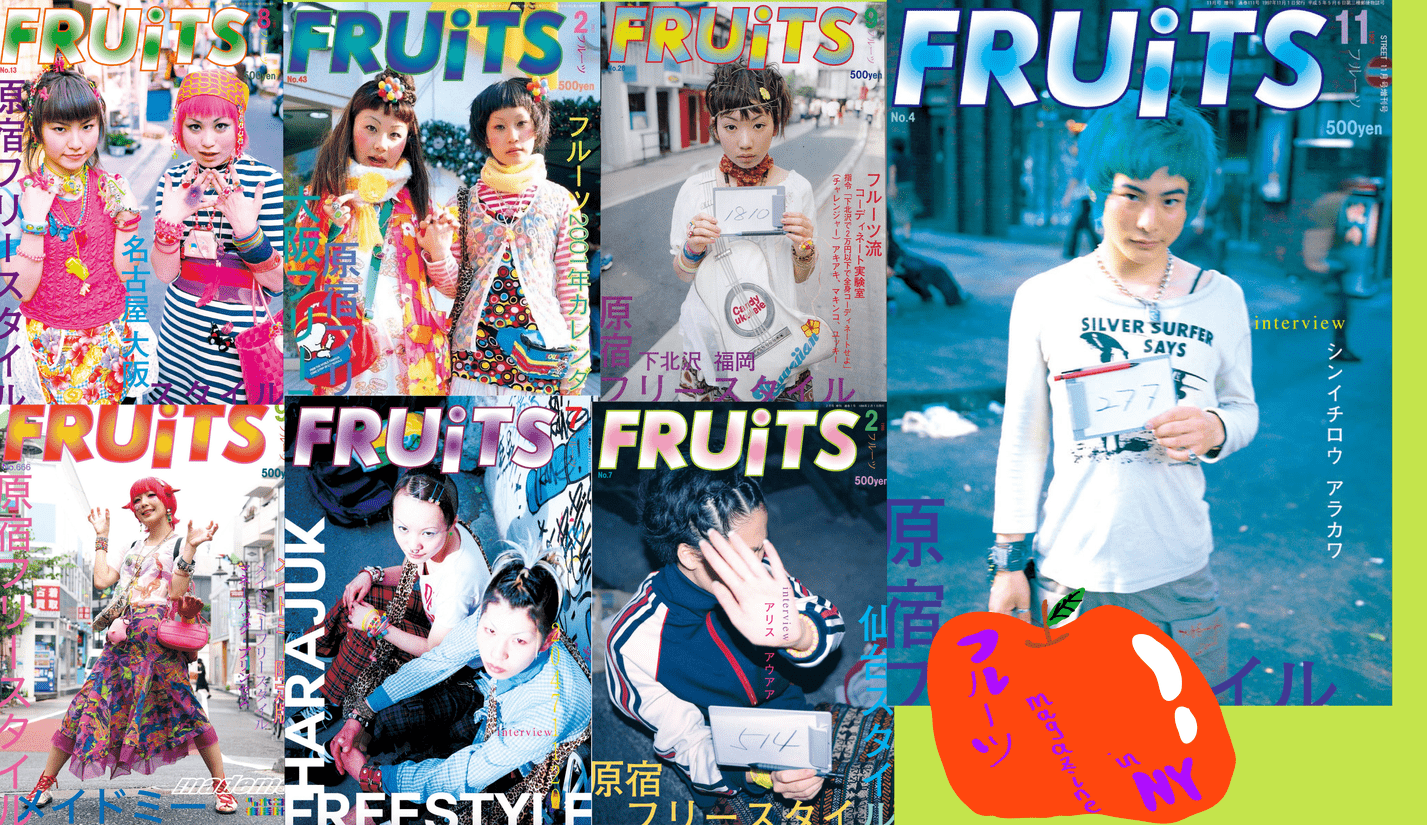There’s this legendary Japanese fashion magazine that I see in New York more than I do in Tokyo: FRUiTS magazine. For fashion aficionados, the name couldn’t be more familiar (They’d find it ridiculous that I’m even having to explain what this iconic, street-style bible is).
FRUiTS was founded in 1997 by photographer Shoichi Aoki. For 20 years, the magazine documented the fashion subculture styles straight from the Harajuku neighborhood of Tokyo, where cool kids with eclectic styles congregated. It was a cultural touchstone in fashion in many ways. Before the street-style snapshots, there was FRUiTS. Before maximalist styling swept the modern fashion world, there was FRUiTS.
The monthly publication chronicled the diverse, colorful outfits of young people. Their styles were trend-less, mixed and most importantly, personal to the wearers. Aoki, the magazine’s founder, chose the name FRUiTS — a stylized version of the word “fruits” — because, “The vividness and the freshness of this novel take on fashion reminded him of strawberries, oranges and other cute fruits,” he told the online culture publication, sabukaru.
The magazine folded in 2017. Its final issue came out in February of that year. “There are no more cool kids to photograph,” Aoki had said when he announced the end of the magazine. He saw the rise of social media and fast fashion change how people dressed, making it less about personal curation and more about single-brand outfits.
So how does this Japanese street-style magazine that was once distributed from the heart of Tokyo end up in New York’s Rizzoli Bookstore today? Or at the designer vintage clothing store on Spring Street? Some devotees are even hunting for it on Reddit.
The New York fashion crowd’s love for FRUiTS is unmatched. They yearn to see the OG street-style magazine, which authentically captured the youth’s madcap fashion, revived. When Aoki’s magazine was released in digital eBook format for the first time in English in May 2023, publications like Vogue and Dazed took notice.
“Publications have learnt to talk about online trends (i.e. stealth wealth and indie sleaze) as if they were embodied movements and not discourse-generated cores,” Daniel Rodgers wrote for Dazed. “Those things have their own value — teaching us about people’s evolving relationship with clothing — but they often overshadow the more interesting stuff that takes place IRL and at nightclubs and art schools.” This makes the return of FRUiTs all the more relevant, Rodgers noted.
And I couldn’t agree more. There are many so-called fashion “cores,” microtrends and aesthetics today that help define how people dress. There was the ballet-core epitomized by Sandy Liang and Miu Miu; “bloke-core” or “blokette” led by Wales Bonner and Balenciaga; and, on a more recent note, the “office-siren-core” — an edgy take on traditional corporate attire that started trending on TikTok. They all pull off their distinctive styles in their own ways, like how the fashion crowds from Aoki’s fashion magazine did. And yet, the predefined “cores” feel like an efficient categorization of how people dress, lumping together the individual’s personal styles into a visually cohesive world.
This explains, perhaps, why a magazine like FRUiTS excites so many fashion freaks even beyond Japan. The personalized styles that were captured in FRUiTS could care less about brands, trends and being boxed into some “core” category. I assume that Aoki hated boxes, hated labels and hated being labeled or placed in a box. But it’s what society, the internet and the fashion world generally tend to do. Trending, out of trend, Gothcore, Clean Girl, Mob Wife, Gorpcore, street, couture — it feels safe to have everything cleanly categorized.
Today, individualism in fashion has become downgraded to trends dictated by the virals, hashtags and posts on social media, especially in American society. In contrast, FRUiTS was about featuring those who defended their unique identity and celebrating how great it feels to be different from one another.
Japan has 264 years of isolationist history (also known as the Tokugawa period; 1603–1867), during which it completely secluded itself from the outside world. This fiercely independent time led to the growth of their own unique culture. This sensibility is also felt in the realm of fashion, explaining why so many unconventional, experimental styles originate from Japan.
Walking through the streets of New York today, I see so many bookstores and boutiques curate FRUiTS, along with other Japanese fashion magazines and photobooks. STREET, Aoki’s other street-style magazine project, which he started in 1985, can be seen on the shelves of 194 New York, a vintage designer boutique on Eldridge Street. CLIMAX Books, an indie bookstore just around the corner from the Bowery Hotel, specializes in selecting photobooks by young female Japanese photographers who are often under-recognized. The selected photobooks, like the ones by the influential Japanese photographer Hiromix, capture the distinctive Decora and Harajuku styles from the ’90s Japanese youth culture.
I guess it’s a testimony to the beauty of individualism. When the whole world becomes more globalized and so many places look the same now, this kind of uniqueness stands out from the masses. This is perhaps why FRUiTS’s documentation of Tokyoites’ eccentric styles attracts the like-minded people here in New York today.


